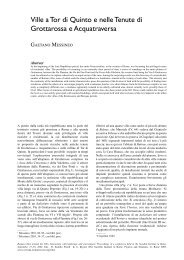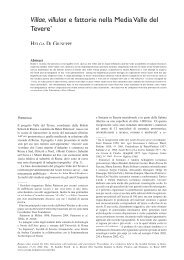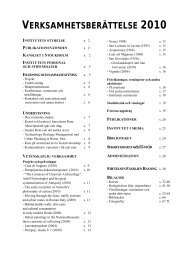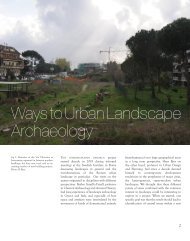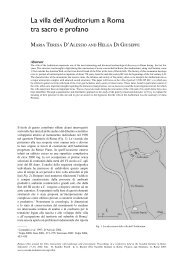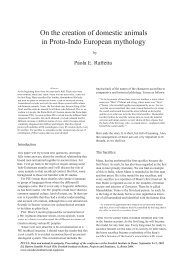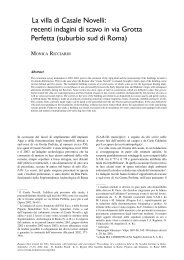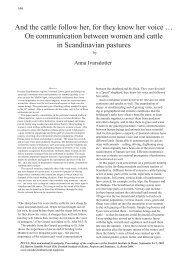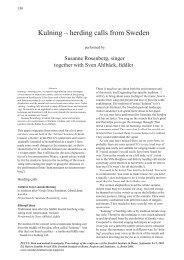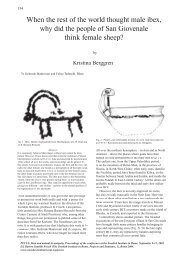Animal husbandry and social hierarchies in Ãstergötland in the Pre ...
Animal husbandry and social hierarchies in Ãstergötland in the Pre ...
Animal husbandry and social hierarchies in Ãstergötland in the Pre ...
Create successful ePaper yourself
Turn your PDF publications into a flip-book with our unique Google optimized e-Paper software.
224<br />
Maria Petersson<br />
Local Cattle % Sheep/goat % Pig % Horse % Teeth %<br />
Dat<strong>in</strong>g<br />
Vistad, Väderstad sn 23 42 30 4 unknown 1000 – 400 BC<br />
Pryssgården, Ö<br />
Eneby sn<br />
48 (51) 32 (32) 12 (8) 8 (8) 70 Late Bronze Age<br />
RAÄ<br />
251, Slaka sn 39 (33) 30 (19) 22 (26) 9 (21) 26 Early <strong>and</strong> Middle <strong>Pre</strong><br />
Roman I A<br />
Abbetorp, area 10<br />
(large farm)<br />
Abbetorp, area 11<br />
(small farm)<br />
Abbetorp, area 10<br />
<strong>and</strong> 11<br />
77 (80) 3 (2) 2 (-) 18 (19) 95 400 BC – 140 AD<br />
50 (39) 2 (-) 1 (10) 39 (51) 76 400 BC – 240 AD<br />
61 (58) 2 (1) 6 (5) 30 (37) 84 400 BC – 240 AD<br />
RAÄ<br />
89, Högby sn 38 (31) 36 (40) 21 (24) 4 (5) 57 Early Roman Iron Age<br />
RAÄ<br />
162, L<strong>in</strong>köp<strong>in</strong>gs<br />
46 (48) 25 (25) 18 (16) 10 (10) 94 Roman Iron Age <strong>and</strong><br />
stad<br />
Migration Period<br />
Herrebro, Borgs sn 44 22 16 18 unknown 600 – 1000 AD<br />
RAÄ<br />
173, Motala sn 53 (51) 16 (15) 27 (34) 1 (-) 49 Late Iron Age <strong>and</strong><br />
Early Middle Ages (670<br />
– 1300 AD)<br />
Stora Ullevi,<br />
L<strong>in</strong>köp<strong>in</strong>g<br />
35 (29) 30 (33) 31 (35) 4 (2) 33 Late Vik<strong>in</strong>g Age <strong>and</strong><br />
Early Middle Ages<br />
Table 1. The sites <strong>in</strong> <strong>the</strong> table are arranged <strong>in</strong> chronological sequence. The percentage of different domestic mammals is given first <strong>in</strong> each cell. The<br />
percentage based on <strong>the</strong> number of teeth fragments is given <strong>in</strong> brackets. (After T B Larsson 1993, Jonsson 1996, Johansson 1993, Sigvallius 2000,<br />
Sigvallius 1996, Men<strong>and</strong>er 1999, L<strong>in</strong>deblad & Nielsen 1993, Sigvallius 2001, Wigh 2000).<br />
The smaller farm at Abbetorp was situated ca. 120 m<br />
east of <strong>the</strong> ma<strong>in</strong> build<strong>in</strong>g of <strong>the</strong> large farm. It was set<br />
on a hillock near a small stream <strong>and</strong> is represented by a<br />
three-aisled house (house 3). Directly south of <strong>the</strong> house<br />
<strong>the</strong>re is a well-def<strong>in</strong>ed farmyard with hearths as well as<br />
cook<strong>in</strong>g pits, <strong>and</strong> immediately north of <strong>the</strong> house <strong>the</strong>re<br />
is a field that is also contemporaneous with house 3. The<br />
three-aisled house was 16 m long <strong>and</strong> divided <strong>in</strong>to two<br />
rooms, one for liv<strong>in</strong>g <strong>and</strong> one for storage e d. The house<br />
was C 14 -dated to <strong>the</strong> period 400 BC – 240 AD. There<br />
were <strong>in</strong>terpretable arrangements made for <strong>the</strong> domestic<br />
animals. The farmyard <strong>in</strong> front of <strong>the</strong> house was fenced<br />
<strong>in</strong> <strong>and</strong> its lack of cultural layers <strong>and</strong> low phosphate<br />
content showed that <strong>the</strong> animals had not had access to<br />
this area. Adjacent to one of <strong>the</strong> gables <strong>the</strong>re had been<br />
a porch <strong>in</strong>terpreted as a milk<strong>in</strong>g place, a shelter for<br />
animals <strong>in</strong> difficult wea<strong>the</strong>r conditions <strong>and</strong> possibly also<br />
a feed<strong>in</strong>g place.<br />
At <strong>the</strong> Abbetorp site <strong>the</strong>re were no conclusive evidence<br />
that <strong>the</strong> houses had ever conta<strong>in</strong>ed a byre, nei<strong>the</strong>r<br />
at <strong>the</strong> big farm nor at <strong>the</strong> small one. In Sc<strong>and</strong><strong>in</strong>avia <strong>the</strong>re<br />
are few examples of byres from this period. A sparse<br />
<strong>and</strong> regular sett<strong>in</strong>g of <strong>the</strong> posts carry<strong>in</strong>g <strong>the</strong> roof <strong>in</strong> one<br />
part of <strong>the</strong> house (generally <strong>the</strong> western part) is by some<br />
scholars <strong>in</strong>terpreted as a sign of a byre section. O<strong>the</strong>rs<br />
have <strong>in</strong>terpreted this as an economy-section with ma<strong>in</strong>ly<br />
storage function <strong>and</strong> call for o<strong>the</strong>r evidence as well. 14<br />
Lennart Carlie considers it more likely that this part of<br />
<strong>the</strong> house was a room where one could house animals<br />
dur<strong>in</strong>g extreme wea<strong>the</strong>r <strong>and</strong> also dur<strong>in</strong>g particularly vulnerable<br />
periods of <strong>the</strong>ir lives. The most valuable animals<br />
such as breed<strong>in</strong>g <strong>and</strong> draught animals might also have<br />
had <strong>the</strong>ir place here. 15<br />
The status <strong>in</strong>dicators<br />
Us<strong>in</strong>g <strong>the</strong> archaeological material from Abbetorp I have<br />
<strong>in</strong>terpreted <strong>the</strong> two farms from <strong>the</strong> <strong>Pre</strong> Roman Iron Age<br />
as two farms of different size. I have also <strong>in</strong>terpreted<br />
<strong>the</strong>m as expressions of a <strong>social</strong> hierarchy exist<strong>in</strong>g <strong>in</strong> <strong>the</strong><br />
area. It is possible that <strong>the</strong> large farm at Abbetorp was<br />
<strong>the</strong> top farm of <strong>the</strong> hierarchy compris<strong>in</strong>g of <strong>the</strong> local<br />
pastoral organisation, as suggested by Mats Widgren. 16<br />
At Abbetorp <strong>the</strong> follow<strong>in</strong>g elements have been <strong>in</strong>terpreted<br />
as <strong>in</strong>dicators of status:<br />
1.The layout <strong>and</strong> size of <strong>the</strong> farmyard where <strong>the</strong> large<br />
farmyard with traces of many different types of activities<br />
with<strong>in</strong> def<strong>in</strong>ed areas is an expression of high status <strong>and</strong><br />
<strong>the</strong> small farmyard with traces of few activities <strong>in</strong>dicates<br />
low status.<br />
2.The number of build<strong>in</strong>gs where <strong>the</strong> farm compris<strong>in</strong>g of<br />
more than one build<strong>in</strong>g is deemed to have higher status<br />
than <strong>the</strong> farm with just one build<strong>in</strong>g.<br />
3.The length <strong>and</strong> layout of <strong>the</strong> dwell<strong>in</strong>g house where <strong>the</strong>



